WENZHOU HIGH-SPEED TRAIN CRASH
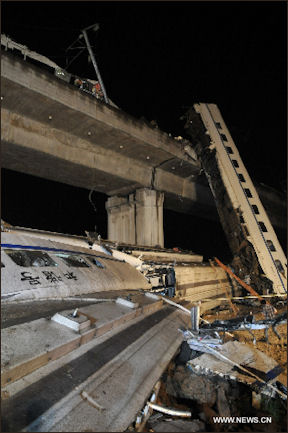
Wenzhou train crash In late July 2011, two high speed trains collided, killing 40 people and injuring 177 in Wenzhou, near Shanghai, in Zhejiang Province in eastern China. The accident occurred when one high-speed train rear-ended another that was traveling at a low speed on an elevated track on a concrete bridge about 15 meters above farms and fields. It was the first derailment on China's high-speed rail network since the country launched its bullet trains in 2007 with a top speed of 155 miles per hour, the China Daily reported.
AP reported, “A bullet train crashed into another high-speed train... causing four carriages to fall off a viaduct. The first train was traveling south from the Zhejiang provincial capital of Hangzhou when it lost power in the lightning strike and was hit from behind by the second train in Wenzhou city at 8:27 p.m. The second train had left Beijing and both trains were destined for Fuzhou in eastern Fujian province...The Ministry of Railways said in a statement that the first four carriages of the moving train and the last two carriages of the stalled train derailed. [Source: AP, July 23, 2011]
The dead included two schoolgirls, an Italian tourist and a pregnant woman who was killed with four family members, according to accounts in the Chinese press. “A preliminary investigation by the Zhejiang provincial government showed that four coaches of the moving train fell off the viaduct, Xinhua said. The cars plunged about 65 to 100 feet from the elevated section of track, it said. Photos taken at the scene showed one badly damaged car lying on its side by the viaduct and another car leaning against the viaduct after landing on its end.”
The Wenzhou crash was a heavy blow for the showcase high-speed railway programme and has invigorated public criticism over the costs and speed with which it has been rolled out. The trains involved are "D" trains -- first-generation bullet trains with an average speed of about 95 miles per hour and not as fast as the new Beijing-Shanghai line. High-speed rail has an excellent safety record elsewhere, especially in Japan, which has never had a fatality.
The Economist reported: After a deadly high-speed train crash in Zhejiang province in July, the authorities sent bulldozers to bury the wreckage. The crash was an embarrassment; a reminder that China’s state-directed rush to modernise has involved cut corners, shoddy safety standards and a staggering amount of corruption. That contradicted the official storyline, in which China has become the world’s second-largest economy thanks to the Communist Party’s wise guidance. Rather than grapple with awkward counter-evidence, the party tried to bury it.
Articles on CHINA’S RAILWAY MINISTRY: ITS AMBITIOUS RAIL NETWORK, LIU ZHIJUN AND CORRUPTION factsanddetails.com ; HIGH-SPEED TRAINS IN CHINA factsanddetails.com ; PROBLEMS WITH CHINA'S HIGH-SPEED TRAINS: HIGH COSTS, SAFETY ISSUES AND CORRUPTION factsanddetails.com ; SHANGHAI SUBWAY COLLISION AND OTHER TRAIN ACCIDENTS IN CHINA factsanddetails.com ; FALLOUT OF THE WENZHOU HIGH-SPEED TRAIN CRASH factsanddetails.com
RECOMMENDED BOOKS: “China's High-Speed Rail Development” by Martha Lawrence, Richard Bullock, et al. | Jun 30, 2019 Amazon.com; “Handbook on Transport and Urban Transformation in China” by Chia-Lin Chen, Haixiao Pan, et al. Amazon.com; “China's Great Train: Beijing's Drive West and the Campaign to Remake Tibet” by Abrahm Lustgarten Amazon.com; “Taking the Train to Tibet” by Chen Yang | Amazon.com; “Riding the Iron Rooster: By Train Through China” by Paul Theroux Amazon.com; “The Last Steam Railways: Volume 1: The People's Republic of China” by Robert D. Turner Amazon.com; “English-Chinese and Chinese-English Glossary of Transportation Terms: Highways and Railroads” by Rongfang (Rachel) Liu and Eva Lerner-Lam Amazon.com; Lonely Planet China" 16 Amazon.com
Events Before the Wenzhou Crash
Evan Osnos wrote in The New Yorker: “At 7:30 P.M., on the outskirts of the city of Wenzhou, lightning struck a heavy metal box beside the tracks. The box, the size of a washer-dryer, was part of a signal system that lets drivers and dispatchers know where trains are. Because tunnels block a radar signal, trains rely largely on hard-wired equipment like the box beside the track, which helps drivers and dispatchers talk to each other and controls a machinelike traffic signal, giving the drivers basic commands to stop and go. When lightning struck the box, it blew a fuse, which caused two catastrophic problems: it cut off communication and froze the signal on the color green.[Source: Evan Osnos, The New Yorker, October 22, 2013]
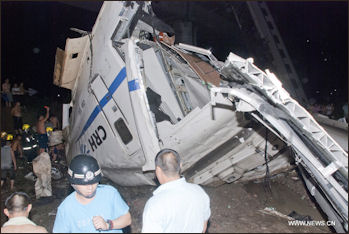
“At a nearby station, a technician picked up garbled signals from the tracks and ordered repairmen into the storm to investigate; meanwhile, he reported the problem to a dispatcher in Shanghai named Zhang Hua. The train carrying the Cao family was still miles away, but D3115, also bound for Fuzhou, with a thousand and seventy-two people aboard, was ahead of D301. Zhang called D3115 to warn the driver that, because of the faulty signal, his train might shut down automatically. In that case, he should override and run it at a cautious speed until he reached a normal section again. As predicted, the computer brought the train to a halt, but when the driver tried to get it moving it wouldn’t start, despite repeated attempts. He called Shanghai six times in five minutes, but couldn’t get through. On his train, a passenger uploaded to the Web a picture of the carriage in darkness and asked, “What happened to this train after that crazy storm It’s running slower than a snail now. . . . Hope nothing is going to happen.”
“Zhang the dispatcher was juggling ten trains by now. Hearing nothing further from D3115, he may have figured that it had re-started and moved on. The train carrying the Cao family was already half an hour late, and at 8:24 P.M. Zhang cleared it to go ahead. Five minutes later, the driver of the first train finally succeeded in re-starting his engine and began to inch forward. When his train reached a normal section of track, it suddenly appeared on screens across the system, as if from nowhere, and a dispatcher saw what was about to happen. The train behind it had a green light and was charging down the track. The dispatcher alerted the driver: “D301, be careful! There’s a train in your zone. D3115 is ahead of you! Be careful, will you? The equipment—” The line cut off.
Victims of the Wenzhou Train Crash
Evan Osnos wrote in The New Yorker: “Train D301 sped south and east across emerald-green paddies toward the coast. To Henry Cao, who was seated beside a window in the last compartment of the second car, the train seemed to float, describing long elegant turns and shuddering now and then with the whump of a train going in the opposite direction. As the sun set, a summer storm was gathering, and Henry watched lightning flicker across the clouds. captured a wobbly snapshot of the digital speedometer at the end of the carriage; it showed the kilometer equivalent of 188 m.p.h. [Source: Evan Osnos, The New Yorker, October 22, 2013]
“The driver of D301, Pan Yiheng, was a thirty-eight-year-old railway man with a broad nose and wide-set eyes. In the final seconds, Pan pulled a hand-operated emergency brake. His train was high atop a slender viaduct across a flat valley, and immediately ahead of him was train D3115, moving so slowly that it might as well have been a wall.The collision impaled Pan on the brake handle[Source: Evan Osnos, The New Yorker, October 22, 2013]
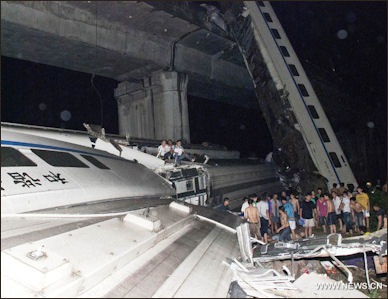
rescue and search after
the Wenzhou train crash The collision threw Henry Cao into the air. His body tensed for impact. None came. Instead, he was falling—for how long he couldn’t tell. “I heard my mother’s voice shouting,” he told me later. “And then everything went black.” His carriage and two others peeled off the tracks, tumbling sixty-five feet to a field below. A fourth car, filled with passengers and spewing sparks, was left dangling vertically from the edge of the viaduct. Henry awoke in a hospital, where doctors removed his spleen and a kidney. He had shattered an ankle, broken his ribs, and suffered a brain injury. When he was alert enough to understand, he learned that his parents were dead. In the chaos of the rescue and recovery, his mother’s ten thousand dollars had also disappeared.
Cao spent five months in a Chinese hospital, recovering from broken bones, neurological damage, and the loss of his kidney and spleen. He could stay awake for only a few hours at a time, and he was easily confused. After returning to his family in Colorado, he had to close his camera-supply business. “I actually feel like I want to die,” he told me. “What’s the point of living when everything you tried to work for . . .” The government offered his family two hundred and eighty-four thousand dollars for his parents’ deaths, and another eighty-five thousand for his own injuries. In August, he and his brother Leo flew to China to retrieve their parents’ bodies. They asked to have a memorial in the ancestral village in Fujian, but the government forbade it; the parents were buried in a cemetery on Long Island. [Source: Evan Osnos, The New Yorker, October 22, 2013]
Cause of the Wenzhou High-Speed Train Crash
In September 2011, the Caijing financial magazine reported that an investigation into a deadly bullet train crash found that faulty signal systems and mismanagement were mainly to blame, though the accident was triggered by a lightning strike. The lightning strike caused one bullet train to stall and a sensor failure allowed a second train to keep moving on the same track and slam into it. Caijing cited one of the experts participating in the inquiry, Wei Zhen, a professor at the Hefei University of Technology. [Source: Associated Press, September 16, 2011]
The Daily News newspaper cited experts warning that the faulty signal systems are still in use at dozens of stations along high-speed rail lines. Reiterating earlier reported findings, it said the crash occurred because a signal that should have turned red when lightning stalled the first train stayed green. Railway staff also failed to notice something was wrong. The Beijing National Railway Research & Design Institute of Signals and Communications Co, which made the signal, has publicly apologised after the crash.
Chinese railway officials have blamed “serious design flaws” in railroad signaling equipment for the high-speed train crash in eastern China that, Xinhua, the official news agency, reported in July. After it was struck by lightning, the signaling device at the Wenzhou South railway station malfunctioned and failed to turn from green to red, An Lusheng, chief of the Shanghai Railway Bureau, told the news agency. He also said workers on duty were inadequately trained and failed to notice the malfunction. This revelation came after six days of silence by the government about why the trains collided. Its initial explanation was terse and vague: equipment failure due to a lightning strike. [Source: Sharon Lafraniere New York Times July 28, 2011]
Mr. An, faulted the quality of equipment and personnel, as well as on-site controls, Xinhua reported. He described safeguards as “still quite weak.” He had been transferred to the Shanghai job only days ago. His predecessor and two other railway officials were fired immediately after the wreck. Mr. An said the malfunctioning signal was designed by a Beijing institute. The Beijing National Railway Research and Design Institute of Signals and Communication apologized Thursday to victims on its Web site, saying it would “shoulder responsibility.”
He Jinliang, director of the China Standardization Association of Lightning Protection Technology, said in an interview that proper equipment would have averted the tragedy. While it might not be cost-effective to make rail equipment “100 percent lightning-proof,” he said, “you can definitely prevent this kind of serious accident.”
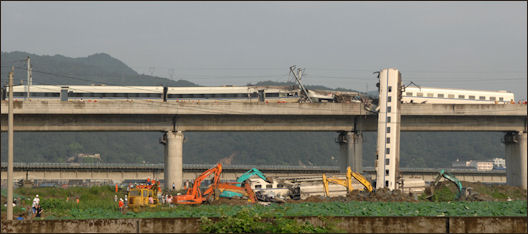
Wenzhou train crash
Japanese Experts Analysis of the Wenzhou Train Crash
Japanese experts said that the moving train was a CRH2 model, a Chinese copy of Japanese Kawasaki Heavy Industries' Hayate Shinkansen (bullet train), which operates on the Tohoku line in Japan. The train that was rear ended was a CRH1, based on technology from Canada’s Bombadier Inc.
Japan's Kyodo news agency reported this week that this model's maximum speed was set at between 200km/h and 275km/h to ensure safety but China began commercial operations at up to 350km/h on some routes. After learning this, Kawasaki Heavy said it had secured a written pledge from China that the Japanese company "would not be held responsible" if an accident was caused by speeding. An anonymous source at Kawasaki told Kyodo that company had long been concerned about the Chinese approach of prioritizing speed at the expense of safety.”
Japanese bullet trains have been equipped with automatic train control (ATC) system since they were introduced in 1964. ATC devices on bullet trains cause trains to automatically brake if they approach too close to one another. Rail safety expert Seiji Abe, of Kansai University, says that if China had implemented the ATC system used across Japan, the rearmost train would have been stopped automatically. He says the ATC system also includes lightning protection, which it appears China has also neglected. Professor Abe, who has worked as a rail crash investigator, says he doubts that Japanese rail companies will suffer any blow to their reputation because it is clear these trains are at best a copy, and probably one that does not include the necessary safety features.
Initial Government Response to the Wenzhou High-Speed Train Crash
The Railways Ministry initially responded to the Wenzhou train crash by stonewalling. State television, whose blinkered coverage of rescued babies only belatedly gave way to careful reports on the public’s discontent. Services on the train line where the accident took place resumed just 1½ days after the accident. Authorities wanted the tracks cleared, fixed up and ready to go within 24 hours but poor weather slowed those ambitions the China Daily reported. For some Chinese the speed in which authorities got the system rolling again was in the words of the New York Times “emblematic of a callous, unresponsive political culture that prioritizes instant results over public well-being and accountability.”
The Economist noted how poorly authorities handled the public relations of the crash. “They first tried to blame the weather (lightning) before faulting the institute that designed the signalling. Rescuers rushed to bury part of the wreckage, either in haste to get the service going again before all the survivors had been accounted for, or because they wished to hide technology (either Chinese, or some lifted from foreign companies). Corpses were not at first handed over to families. And Grandpa Wen took days to pay his respects to victims. He had been sick, he said, which raised more questions than it answered
Ian Johnson wrote in the New York Times, “In official, government-approved accounts of the accident, officials moved quickly to take charge of the situation. On Sunday morning, President Hu Jintao declared that rescue efforts were a top priority. The government also announced that three senior officials in the Railway Ministry had been fired. The railway minister was said to have taken charge of the rescue operation. But competing narratives already began emerging Sunday. On the feisty microblogging site Sina Weibo, postings said that the minister, Sheng Guangzu, who took over this year when his predecessor was fired for corruption, had been cornered by angry journalists after he dodged interview requests. [Source: Ian Johnson, New York Times July 24, 2011]
Other reports on the site said the ministry was burying parts of the wrecked trains near the site, prompting critics to say that the wreckage needed to be carefully examined for causes of the malfunction. More confusion emerged over efforts to portray nature as the culprit in the accident. Xinhua reported Saturday that the first train lost power when it was hit by lightning, and national television broadcasts emphasized pictures of lightning storms in the area. But later reports by Xinhua said the supposedly stalled train was under way when it was struck by the other train. Also left unexplained was why railway signals did not stop the second train before it hit the first one.
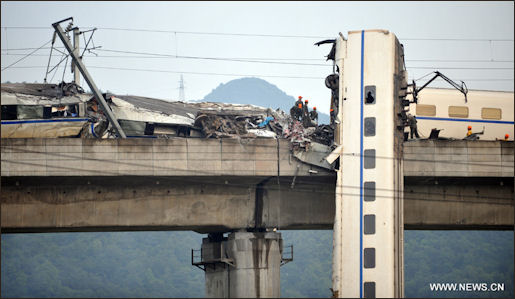
Wenzhou train crash
Rescue of Two-Year Girl After the Rescue for Wenzhou Train Crash was Called Off
The Wenzhou city government said more than 1,000 people participated in the rescue operation. Xinhua quoted an unidentified witness as saying, "Rescuers have dragged many passengers out of the coach that fell on the ground." About 1,500 passengers were taken to a middle school, and more than 500 residents had given blood by 9 a.m. Sunday after appeals from the local blood bank, which said many of the injured needed transfusions, CCTV reported. [Source: AP, July 23, 2011]
Some Netizens watching video images and reading reports from the scene said it appeared authorities were burying the rail cars and had abandoned the search for survivors about six hours after the accident. Chinese President Hu Jintao and Premier Wen Jiabao called for an all-out effort to rescue passengers still trapped in the wreckage the morning after the collision several hours after China Central Television said the search-and-rescue operation had ended.
A two-year-old girl Xiang Weiyi was discovered alive in the wreckage and rescued 21 hours after the train crash and 14 hours after the search and rescue had officially ended. This touched off a deluge of criticism over what was seen as a blatant disregard for human life. Microbloggers asked whether her parents and others could have been saved had the rescue effort not been called off.
According to the China Daily the girl was pulled from the wreckage after a local police chief iniste the carriage be checked gain before it was pushed off the elevated track. Wang Yongping, a rail ministry spokesman, said at a July 24 news conference the girl’s survival was an example of "the miracle of life." He was derided by many in the online community. The spokesman was removed from his job in August and posted to Poland in a diplomatic role. [Source: Bloomberg News, September 18, 2011]
Burial of Railway Car and Quick Clean Up at the Wenzhou Train Crash Site
Railway authorities decided to bury the derailed first car of the oncoming train at the site of the accident. The railway ministry said the car was buried so a crane could move into position, according to a statement on its website. The ministry also said the trains contained valuable “national level” technology that could be stolen and thus must be buried “even though foreign companies have long complained that the technology was actually stolen from their trains.
After an online outcry charging a cover-up and destruction of evidence, the carriage was dug up and taken to Wenzhou for analysis. China Daily, the state-controlled English-language newspaper, noted that they had met the request of “many netizens.”
China's state news agency Xinhua has denied widespread rumours that railway authorities tried to conceal evidence by burying carriages. Citing an unnamed official with the Ministry of Railways, Xinhua said that "the problem of burying rail carriages and 'destroying evidence' does not exist during the handling of the whole of the accident".The report said that only the damaged parts of some carriages were buried at the site in order to facilitate clean-up and rescue operations.
Asked why the accident site was so hastily cleaned up, Mr. Wen said the government’s first priority was to rescue victims. As soon he learned of the accident Saturday night, he said, he called the railway minister with a two-word order: “save people.”
An official identified only as being in charge of a major train station told the Economic Observer, a Chinese economic weekly, said China's railway authorities usually destroyed evidence when an accident occurred. He said that burying the train car was a typical cover-up attempt. "The same thing is always done, but this time there was just more media attention," he was quoted as saying. The railway official was quoted as saying, "When there's a problem, railway officials think about how to avoid responsibility. [Source: Yomiuri Shimbun, August 2, 2011]
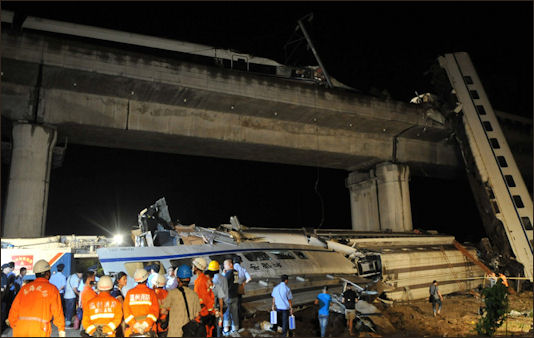
Wenzhou train crash
Chinese Research Firm Takes Responsibility for the Wenzhou Train Crash
A Chinese railway research institute took responsibility for the accident, which has been blamed on faulty signalling equipment. Railway authorities said a signal, that should have turned red after lightning hit the train that stalled, remained green, and rail staff then failed to see something was amiss, the state-run Xinhua news agency said. [Source: Fayen Wong, Reuters, July 28, 2011]
Reuters reported: “The Beijing National Railway Research & Design Institute of Signals and Communications Co. Ltd., in a rare admission of responsibility for a disaster, issued an apology, acknowledging it was the source of the deadly flaw. The Institute would "face up to shouldering responsibility, and accept any punishment that is due, and will strictly undertake pursuing culpability of those responsible", Xinhua reported, citing an institute statement. "Safety overrides all else, and high-speed rail safety is of even more overriding importance," said the Institute.
The admission of guilt came in the face of public ire about the accident that has escalated into angry accusations that officials had covered up facts and stifled media coverage to protect an ambitious rail expansion plan and the Communist Party's image of unruffled control. An editorial with the headline “No Development Without Safety” on People’s Net, the government-run Web site affiliated with the party’s leading newspaper, People’s Daily, said the Railway Ministry had warned of the risks of lightning in a notice four days before the crash. It said new procedures were needed to prevent accidents. But it noted that these measures had not been put into effect, implying that the railway had no emergency plans for trains struck by lightning. [Source: Ian Johnson New York Times July 24, 2011]
Wen Jibao Visits the Wenzhou Train Crash Site
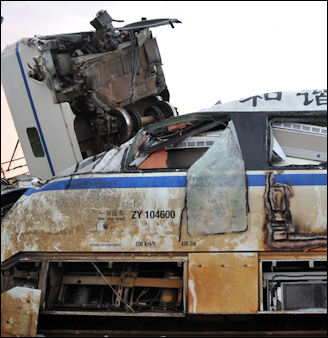
Wenzhou train crash Prime Minister Wen arrived in Wenzhou five days after the tragedy. He said he arrived so late because of illness. At an hour-long news conference at the site of the crash he promised a transparent investigation and pledged more focus on safety and greater accountability. “Our investigation must affirm our responsibility to the people, whether it was an equipment problem, a management problem, or a production problem,” Mr. Wen said. “We must get to the bottom of this. If there is any corruption exposed in the investigation, we will handle it according to the law, and the consequences will be severe.”
The prime minister credited the nation’s rail industry with tremendous progress, but said, “This incident reminds us that we should pay more attention to safety during high-speed rail construction.” On why he showed up so late the 68-year-old Wen said “I’ve been ill recently, on a sickbed for 11 days...”Today my doctor reluctantly allowed me to travel.”
Although news conferences of top leaders typically are broadcast live, China’s central television network, CCTV stuck to its normal programming throughout the event, prompting some Chinese to question whether the network was censoring the prime minister. Users of Sina Weibo, a microblogging site, kept up a running commentary. One writer questioned how Mr. Wen could have been confined to a sickbed for 11 days when the Chinese news media reported that he attended several meetings with foreign officials and hosted two sessions of the State Council, China’s cabinet. Others defended him.
Although Wen's visit appears to have gone some way toward salving public anger, many Wenzhou citizens are still furious that the accident happened at all, underscoring the challenge Beijing faces to win back people's confidence. “His job is not easy, with everyone below him being completely incompetent,” read one post, from a woman in Shanghai. Another, from a man in Urumqi, said: “Every time he appears, he looks more aged and tired. There are always disappointing officials who force him to worry more.”
Attempts by the Chinese Government to Bury the Wenzhou Train Crash Story
A week after the crash, Chinese media received an order from national authorities to "calm down" coverage. They were told to focus on positive news or information from the authorities, according to a copy seen by Bloomberg News. The Economic Observer, a Beijing-based national business weekly, was among publications that defied the gag order, printing an open letter to the rescued orphan Xiang on its August 1 front page starting "Dear Yiyi," which said: "This country has created one economic miracle after another. They claim that’s for people’s benefit, but wouldn’t slow down to listen to the living beings." [Source: Bloomberg News, September 18, 2011]
David Bandurski wrote in the New York Times, “From the outset, China’s government did its utmost to keep public doubts from gathering speed. The Central Propaganda Department instructed media across the country to avoid hard questions and focus instead on “stories that are extremely moving, like people donating blood and taxi drivers refusing to accept fares.” The overarching theme, it said, should be “great love in the face of great tragedy.” [Source: David Bandurski, New York Times, July 28, 2011]
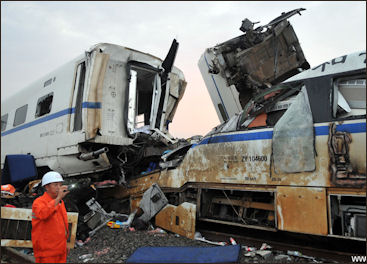
Meanwhile, China’s rail ministry cited lightning as the cause of the accident, sidestepping questions of human error and institutional failure. When journalists asked pointedly how a young girl had been found alive after officials called an end to the rescue effort, the ministry again favored emotion over candor, calling the discovery a “miracle.”
Ordinary Chinese, primarily through the Internet, insistently pushed the Wenzhou tragedy front and center, refusing to accept the government’s rationalizations and distractions. Using Twitter-like platforms on an unprecedented scale, people have clamored for answers to a hornet’s nest of questions. How was the accident caused by lightning? Why was the train behind not aware there was a train in front? Why was the rescue effort halted so soon? Why was the wreckage piled up into shallow pits before there had been a proper investigation into the accident’s cause? Why has a list of victims not been made public?
Magazines and newspapers followed suit, reporting boldly on the facts and pressing for answers. At the very heart of all of these questions “and indeed of the tragedy itself “is a government that refuses to be held accountable for its decisions, and that admits no criticism when criticism might make the difference between bold vision and monstrous folly.
Image Sources: Xinhua
Text Sources: New York Times, Washington Post, Los Angeles Times, Times of London, The Guardian, National Geographic, The New Yorker, Time, Newsweek, Reuters, AP, Lonely Planet Guides, Compton’s Encyclopedia and various books and other publications.
Last updated July 2022
